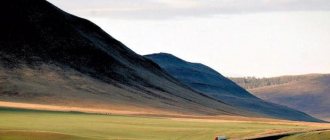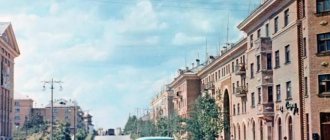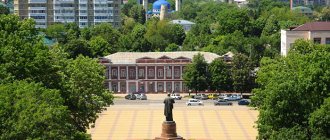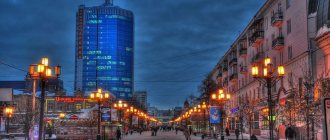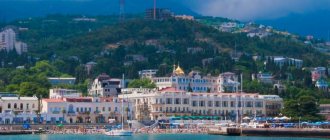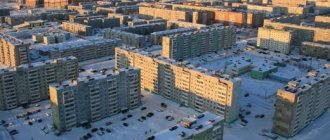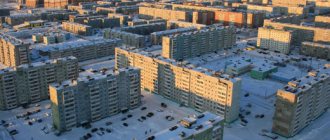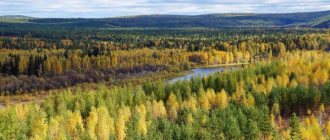origin of name
Chechnya, where Gudermes is located, has a population of approximately one million four hundred thousand people. At the same time, the population of Gudermes is about fifty thousand inhabitants. Most of the Chechen Republic is located in the valleys of the Terek and Sunzha rivers. One of the tributaries is the Gums River, people from the banks of which founded Gudermes. However, this version is considered nothing more than an ancient legend, and the reliable origin of the name has not yet been determined by scientists. According to another version, the name is of ancient Turkic origin and is translated as “shadow side.”
However, there is a more reliable version of the origin of the city, according to which it was founded in the 17th century by residents of high mountain villages. The main mosque of the City is now located on the site of the first settlement.
People associated with the city
- Yamadayev, Dzhabrail Bekmirzaevich (1970, Gudermes - 2003) - Hero of the Russian Federation
- Yamadayev, Ruslan Bekmirzaevich (1961, Gudermes - 2008) - Russian political figure, Hero of the Russian Federation
- Yamadayev, Sulim Bekmirzaevich (1973, Benoy village - 2010) - Russian military leader, Hero of the Russian Federation
- Raduev, Salman Betyrovich (1967, Gudermes - 2002) - one of the most famous representatives of Chechen field commanders. Convicted of terrorism
- Kurbanov, Lechi Alkhazurovich (b. 1978, Gudermes) - Russian karateka and kickboxer, multiple medalist and champion of Russia, international master of sports
- Avtorkhanov, Alikhan Khusainovich - Russian boxer of Chechen origin, medalist of the Russian Championship, Master of Sports of Russia.
History and geography of the region
The region in which Gudermes and the entire Chechen Republic is located belongs to the North Caucasus, which has served for many centuries as a place of residence for a wide variety of cultures, religions and peoples. People have lived in these places since ancient times, and many peoples of the region trace their ancestry back to the Sarmatians, Alans and Huns. Even the Arab conquest “reached” the territory that the Chechen Republic occupies today, with which the religion of Islam appeared in the region.
Today it is not difficult to find a photo of where Gudermes is located, especially on a map of military operations from the time of the two Chechen wars. During these years, Gudermes suffered great destruction. However, after the completion of military operations in the North Caucasus, quite a lot of time passed, and through the joint efforts of the authorities, the small city was completely restored. It took on the appearance of a picturesque and architecturally beautiful place.
About the origin of the village of Gudermes
A lot has been written about the origins of the village of Gudermes, including by the author of these lines. Analyzes by local historians of the historical roots of the “second Chechen capital” practically do not disagree on the main questions: who and when were the first to settle on these fertile lands near the Gums River.
Of course, no one can give a specific date for the beginning of the history of Gudermes. There are no archival documents on this matter. If they exist, they have not yet been made public. We can rely on folk legends, which say that the beginning of the 18th century should be considered the birth years of Gudermes. Yes, people lived on these lands before, and, for sure, they were Chechens. During Timur's invasion at the end of the 14th century, they had to retreat before the powerful military force of the nomads and move to the mountains. At that time, they began to build battle towers and defend themselves in mountainous conditions, where they did it best.
In the northwestern part of the outskirts of Gudermes, within the historical area of Gums Court, even random excavation work produces amazing results: countless burials, very interesting artifacts - shards, jugs, accessories for throwing tools, stone sculptures, etc. All this suggests that Gums Court is a place that needs to be studied through archaeological excavations. Chechen historians know that here it is possible to “produce an impressive result,” but no one is in a hurry to initiate this issue and use the necessary levers...
Taking into account the Vainakh peculiarity of remaining faithful to their native land, it can be assumed with little risk that at the beginning of the 18th century the first inhabitants of the village of Gumse were returning to their historical roots, and did not occupy lands that were new to them. On problematic issues, they were able to come to an agreement with the local “masters”, and we can conclude that the parties found a common language within the framework of historical justice...
Sooner or later, all aspects of local history will be in demand and carefully studied by the scientific community, and we will finally find out what underground attractions of antiquity we are walking over today...
My previous work on historical research regarding Gudermes was published twice on the pages of “Gums” and posted on the Internet, and therefore there is no need to repeat the basic points. I want to dwell on those issues that have not yet been covered and have not yet been raised by me. There are skeptics who claim that the birth of Gudermes took place much later than other villages of the Kachkalyk zone, and at the same time they refer to some of the works of A. Berger, they say, he has no information about this settlement. Yes, in one of the documents signed by Berger, Gudermes is indeed not mentioned among other villages, but this is simply an omission. In his main work “Chechnya and Chechens” this toponym appears. In the first chapter “Geographical and topographical description of Chechnya” you can read: “Kachkalykovtsy. Until 1840, this was the name given to the Chechens who lived along the northeastern slope of the Kachkalykovsky ridge (on this slope again (!) the auls were settled: Gudermes, Istisu, Noy-bero-aul, Oy-sungur...). If “re-settled”, it means that these settlements took place there before.
Second. There are historical writings indicating that the village of Gudermes existed in the 40s of the 18th century.
And now about who are the founders of the village of Gudermes. There is no doubt that these are people from the Chechen mountain village of Chartali, which, with the establishment of Soviet power in the Caucasus, remained within the administrative territory of Georgia.
In Gudermes there are residents from the Chartoy teip, who today, already at the nekyi (teip subdivision) level, present themselves as “pioneers.” I responsibly declare that there are no grounds - arguments or facts - that allow them to “pull the blanket” on themselves, and are not expected in the future. The first could be the ancestors of the suntar-neky, and tsugi-neky, and gai-neky. But no one today can say for sure which of them. One can definitely say: one of them. Part of the village of Gumse with crooked streets and near Gums is the site of the “landing” from Chartali three centuries ago. Later, migrants from other mountain villages joined: G1umkhoy, G1ordaloy, Enakhalloy, Gilnoy, Zandakhoy, etc. They all got along well, there were rare cases of bloody quarrels, although facts of this kind did happen. For example, the founder of the village on the Terek Khangish-Yurt - Khangish - came from the village of Gudermes, and ended up in those places at a time when he was declared “persona non grata” in his native place because of blood feud. The same fate befell my fifth ancestor, at whose hands one of the village residents representing the teip, G1umkhoy, died. This was after the fall of Shamil, but before the collapse of the Tarkin Shamkhalate, that is, after 1859, but before 1867. At that time, the Chechens had good contacts with the Tarkin Kumyks, and Tarki often became a refuge for our people expelled from their homes due to “vendetta.” Due to these circumstances and reasons, 150 years ago, my distant ancestor ended up in the capital of the Tarkin Shamkhalate, where he spent some time and passed away into another world. After his death, the widow had the opportunity to return to her homeland, which she did with her sons. Their names were Yanda, Yandarkha, Keda and Durda. Yanda is the progenitor of the Borkhadzhievs and Yandievs, Yandarkha of the Aptsaevs and Magomadovs, Keda of the Alabaevs, Madievs and Zarmaevs, and finally, the Durdaevs and Arsaevs “came from Durda”.
Yanda had 4 sons - Borkha, Yaho, Mukush and Bana. Of these, the most authoritative was Borja, who, as a young man, devoted himself entirely to the study of Islam. In the last decade of the 19th century, he was invited by the residents of the village of Gerzel-Aul to lead the local mosque as an imam. He performed these duties there for almost 15 years. From the Gerzel mosque he made the hajj to Mecca for the second time (the first time from the Gudermes Aul mosque). Both times the pilgrimage was carried out on foot. On one of these missions, he was received with honors by the political and religious leader Jamalutdin, who awarded Borkha a clergyman’s robe decorated with gold...
After that, he returned to Gudermes, and then moved to a small settlement near Sunzha - Bori Khutor. This place of residence took its name from his name: he was popularly known as Bora...
He died in 1919 and was buried in a cemetery in the vicinity of Gudermes in the direction of Ilshan-Yurt. His brother Yaho lies nearby, whose descendants, I repeat, today bear the surname Yandiev. Mukush had an only son, Hamid. He died before the eviction - in the late 30s. He had a daughter named Ganapu. On the morning of February 23, 1944, she died tragically. That morning, people were being taken out of the “aul” in American Studebakers, and one of the cars on the way to the station fell into a large hole and overturned. People died: three people from the Kaplanov family and young Ganapa... The dead were not even allowed to be buried...
Bana also died early. Unlike his brother Borja, he was more “secular.” At any weddings and parties he was the central character due to the fact that he danced beautifully. His only son Lila, an officer in the Red Army, died in the late 40s in the Finnish events. Borkha had three sons - Magomed, Mahmud and Yahya. The latter continued the work of his father - he was a very authoritative theologian. He was persecuted by the NKVD and miraculously escaped repression. He died on April 26, 1945 and was buried near the city of Temirtau in Kazakhstan next to his brother Magomed. Mahmoud died shortly before the eviction...
But let's return to the topic of gradation of the village of Gudermes. By the middle of the 18th century it was well known, being a place of large and noisy trading gatherings along with the village of Braguny. The bazaar was held on the site of today’s “aul” kindergarten and mosque. Many representatives of other nations came here to buy and sell goods - Russians, Mountain Jews, Kabardians, Circassians, Kumyks... There was something to sell and something to buy. The Gudermes Chartoy residents also explored other places in search of a better life. It is known for certain that many of them moved closer to the Cossack villages and founded new villages in Priterechye.
There was no main mosque in the village for a long time. This was explained by the fact that Islam was just taking root and for the time being believers made do with houses of worship. The large mosque was “rebuilt” in the early 90s of the 19th century. Its area was an order of magnitude smaller than today, and could accommodate up to 500 parishioners. The first imam, apparently, was Sulim Askhadov. And Borkha read sermons there from the very beginning, and then responded to the call of the residents of Gerzel-Aul and became an imam in the local mosque.
On March 23, 1919, Gudermes became a hotbed of great tension. For several days in a row, negotiations were held here with Denikin’s General Dotsenko on the subject of not offering resistance. The residents of Aul ultimately rejected the proposals of the “White Guard,” and the village suffered the same fate as Tsotsi-Yurt, albeit with fewer losses in manpower. By the way, the Russian-speaking part of the population did not resist Dotsenko’s units. The “Whites” drove along the railway with artillery on platforms, installed guns at the station and began to mercilessly fire at the “aul”. Many by this time had managed to move to neighboring Ilskhan-Yurt, so the number of deaths was not as high as in Tsotsi-Yurt. The victims were mainly in the camp of the defenders, who concentrated on the approaches to Gudermes. During the artillery shelling, my grandmother’s only brother, Bisolta, was killed among others. The 18-year-old boy took up defensive positions on Gooms Court, declaring that he could not stay at home when enemies came with weapons in their hands to the land of their fathers. Bisolta was buried in a safe place - on the outskirts of Ilshan-Yurt. During the shelling, many houses of Gudermes residents were destroyed and the mosque, especially the minaret, was badly damaged.
Then hard times followed. The country of the Soviets launched an all-out struggle against religious authorities, and until 1928 the Gudermes Muslims were unable to restore their main temple. And that year, the residents of the village mobilized their forces and carried out major repairs to the mosque, which after that received parishioners until 1937, although the authorities tried in every possible way to prevent this. Particularly treacherous blows were dealt to spirituality in 1932, and then in 1937, when the best sons of the village of Gudermes, leading theologians, were subjected to repression. All local mullahs, without exception, were arrested and put through the millstone of torture. Abubakar, —————————— and others never returned home... The mosque was closed for a long time and restored only in 1981 (along with the Staro-Atagin mosque - the first in the republic).
The son of Abubakar, Abdurashid, was chosen as imam. Shaikhi Sahabov became his deputy. And my father Ramzan (Ahmed) preached sermons until the spring of 1994. In 1994, on April 30, Friday, he preached for the last time. Under his leadership, the parishioners performed a ritual - tobadar. It was on Friday rube. The next day he went to Mecca, although he did not feel well. Having completed one of the fards of Islam, he returned home at the end of May. The trip really broke him. On the 13th day of his return - June 8, he passed away. Exactly 80 days later, Imam Abdurashid-Hadji passed away. Incredible, but true: they stopped their life clocks at the same time: 23:45 (!)... That summer of 1994, the Gudermes land was noticeably orphaned: with these people, an entire era of true servants of Allah passed away...
At the same time, the village of Gudermes also had its own intelligentsia - teachers who stood at the origins of the development of school education within the same village in the 30-40s. Even if we are talking only about primary classes, but nevertheless it was vitally necessary: the country set a course to eliminate illiteracy, schools were built everywhere, teaching staff were rapidly trained, and in these conditions it was important to have local Chechen teachers. At that time, parents often did not allow their children to go to school, and Chechen teachers worked a lot with local residents, telling them about the importance of studying and raising children in the new realities. And all this was beneficial: there were more and more people willing to study.
In 1928, primary school No. 2 opened in the “aul”. For these purposes, they rented a private house, where the library was later located. A few years later, new buildings were erected for the school - several adobe buildings, in which the children studied until the early 80s. By that time, two other houses stood side by side - brick, more modern. But all this was demolished in the first half of the 80s and in their place a 3-story school was built, which was inaugurated in 1985.
A kind word should be given to the first aul teachers, who are no longer alive today, but they will forever remain in the memory of people. These are Ani Ismailov, Ali Dadagov, Abdulkadyr Bakaraev, Abubakar Akhmadov and Takha Yusupov. Young Khamid Yusupov followed in their footsteps, and at the age of 17 he became the director of the village school. And this was not long before the deportation of the Chechens... After the Chechens returned to their historical homeland, their valiant work was continued by Nurdin Abzotov, Said-Selim Shovkhalov and Gabatsu Lakaev. The first of them was generally the first teacher of the native language in middle and high schools in the city of Gudermes. After retiring, he joined the editorial team of the Gums newspaper, where he has served faithfully for 15 years.
Said-Selim was also the director of his native school, and then taught at the Gudermes Pedagogical College. Gabatsu Lakaev also completed his teaching career there. The last two are no longer alive today. During their lifetime, they were friends with the local newspaper and left behind works in the field of local history and history of Gudermes.
The old residents of the city have fresh memories of the appearance of the village before the eviction and after their return. Until 1944, the village did not have its own cinema and young people had to get acquainted with films within the city - at the railway club or at the Komsomolets cinema. Having returned to their historical homeland, the “aul residents” discovered a new object next to the mosque - a city cinema, where they often spent their leisure time. Women also went to the cinema, especially when Indian films were shown. It was a full house and, as a rule, there were not enough tickets.
Until 1961, the village of Gudermes was a separate administrative entity. It contrasted sharply with the appearance of the city itself, where the streets were well-groomed and more or less comfortable. And in the “aul,” especially in rainy weather, the streets were buried in mud, and this was especially true for the area around the cinema, because streams from the mountainous surroundings flowed here. There was no bus service, houses were not supplied with gas, and there was no electricity in most residential areas. The situation began to improve when the village of Gudermes was abolished and it became part of the city. And in the early 70s, when the Gudermes City Executive Committee was headed by Ubaid Ismailov, in the “aul” they first paved the central street named after Kh. Nuradilov, and then the parallel one named after Tchaikovsky. This made it possible to start bus service. I remember how inspired people were when a small KAVZ route bus drove along these two streets for the first time. It really was a holiday for the locals.
In conclusion, I would like to name the names of people - the indigenous inhabitants of Gudermes, who left a good mark in restoring the good name of the Chechens in the 60-70s. In addition to the teachers mentioned above, these were doctors: Sultan Tagiyev, Vakha Alabaev, Alaudi Khadisov, Umar Apkaev, Shadid Aptsaev, Said-Magomed Gezemiev, artist Amanda Asukhanov, athletes - boxers Mahadi Dakaev, Mairbek Shamilov, Abu Borkhadzhiev, Vakhit Alabaev, Nasrudi Bashkhadzhiev , Ruslan Etiev, Akhmed Mutsaev, Isa Chagaev and their coach Magomed Magomadov, wrestler Turpal Tavmurzaev, journalist Bukhari Abzotov, party and economic leaders - Said Berdukaev, Said Ismailov, Madaev brothers, Lema Tovmurzaev, Khas-Magomed and Magomed Gezemievs, Uvais Etiev, Khozh-Akhmed Jamalkhanov, Tahir Dadagov, Khadi Ismailov, Shamil Yusupov, Sharip Khadzhimuradov, and a little later - Said and Sahab Dabachkhadzhievs, Lom-Ali Tavmurzaev, Rizvan Khadchukaev, Badruddi Saidov, Rizvan Chagaev and others.
After them, young cadres from the “aul residents” grew up, who led large organizations, enterprises and institutions. These are: Akhmed Khadchukaev, Sheikh-Akhmed Dudurkaev, Abdurakhman Esendirov, Buvaysar Kanaev, etc. At the beginning of the crazy 90s, all the key positions in the district government were occupied by representatives of the “aul” of Gudermes: Khusein Sadykov - chairman of the district council of deputies (later he was replaced by Ramzan Lechkhadzhiev), Adlan Chuchuev - first secretary of the city committee of the CPSU. The people's judge was Zara Ismailova. Before the first military campaign, the executive branch in Gudermes was headed by Akhmed Mutsaev. In 1996 The prefecture of the Gudermes region was headed by Magomed Kuchiev. During Maskhadov's reign, Aslanbek Akhmadov was the mayor of the city. At the end of the 20th century, after the liberation of Gudermes from militants, the area was headed by Malika Gezemieva. She was replaced a year later by Akhmed Abastov, who remained in power until 2005.
In recent years, the following have made careers: Supyan Lechkhadzhiev, Zaurbek Saidov, Nurid Borkhadzhiev and Murad Tagiyev, who headed the ministry and committee of the Government of the Chechen Republic. Members of the Parliament of the Chechen Republic are Ramzan Lechkhadzhiev and Said Yusupov.
Karatekas Lecha Kurbanov, Shamil Lokaev and Anzor Abastov performed well in the sports arenas of the world, becoming European champions. The winners of the Russian championship and prestigious international competitions were: Khusein Elikhanov, Adlan Abzotov, Yusup Guchigov and others. Tamerlan Bashkhadzhiev shows excellent results in powerlifting. The indigenous people of Gudermes also have successes in the creative field: Honored cultural workers of the Chechen Republic are artists Nasrudi Dabachkhadzhiev, Aindy Shamilov, journalists and poets Ruslan Yusupov and Khozhbaudi Borkhadzhiev. The latter also has the title of Honored Journalist of the Czech Republic.
This track record goes on. And it’s good that there were and are people who, with their military labor and talent, contributed to the political, social and economic development of not only the city and region, but also the entire republic.
Today, the “aul” of Gudermes is one with the city, which was the first in the republic to be rebuilt and landscaped. His story will always be with us, in our souls. Time will pass, and the realities of today will become history, for life does not stand still, life goes on. And let it be happy and joyful, at least for those who do good deeds.
And, of course, on the eve of the 70th anniversary of the Great Victory, I would like to name the names of the brave front-line soldiers mobilized from the “aul” of Gudermes. These are: Said-Akhmed Alibekov, who was twice nominated for the title of Hero of the Soviet Union, brothers Khamid and Gani Kurazov, Amanda Dabachkhadzhiev, Baudi Gaisumov, Abdurakhman Akhmadov, Ali Eltemirov, Tapa Alabaev, Askhabov - the heroic defender of the Brest Fortress, and many others. Their glory is unfading, and their feat is immortal.
Modern Gudermes
Despite the fact that Gudermes has a long history, today it consists almost entirely of newly built houses and public buildings. The proximity of the capital also affects the quality of life in the city, because Grozny is located only forty kilometers from Gudermes. The two cities are connected by regular bus routes. In the Chechen Republic, special attention is paid to the quality of the road surface; here it is at a high level. As a result, private road transport is very popular in the region.
As for attractions and entertainment in the city itself, for a small provincial town there are unexpectedly many opportunities to have a good time. The communication center of the city, attracting young people, is one of the central city squares, where the fountain is located.
In addition, like in many other cities, Gudermes has a small local history museum, which displays everyday items of the local population. Gudermes, where many sports schools are located, is called the sports capital of Chechnya, because many famous wrestlers and athletes come from there.
Activity
The station carries out:
- sale of tickets for all passenger trains;
- baggage reception and delivery;
- acceptance and delivery of wagonload shipments of cargo allowed for storage in open areas of stations;
- acceptance and delivery of small shipments of cargo requiring storage in indoor station warehouses;
- acceptance and delivery of cargo by wagonload and small shipments, loaded with whole wagons, only on access roads and non-public areas;
- acceptance and delivery of wagonload shipments of cargo requiring storage in indoor station warehouses;
- acceptance and delivery of cargo in universal containers with a gross weight of 3.3 (5) and 5.5 (6) tons at stations.
Education
Preschool education
- Kindergarten No. 1 “Rainbow”[30].
- Kindergarten No. 2[31].
- Kindergarten No. 3 “Dream”[32].
- Kindergarten No. 4 “Berkat”[33].
- Kindergarten No. 5 “Khadizha”[34].
- Kindergarten No. 6 “Teremok”[35].
- Kindergarten No. 7[36].
Secondary education
- Secondary school No. 1[37].
- Secondary school No. 2[38]
- Secondary school No. 3[39].
- Secondary school No. 4[40].
- Secondary school No. 5[41].
- Secondary school No. 6[41].
- Secondary school No. 7[41].
- Secondary school No. 8[41].
- Secondary school No. 9[42].
- Secondary school No. 10[43].
- Secondary school No. 11[44].
- Secondary school No. 12[45]
Notes
- ↑ Suleymanov A. Toponymy of Chechnya. Grozny: State Unitary Enterprise “Book Publishing House”, 2006
- ↑
- ↑. Retrieved April 24, 2021.
- ↑ Borkhadzhiev H.
Truly Gudermes is a city of miracles // Gums: newspaper. - 2010. - May 5. - Yuri Sergeevich Osipov Great Russian Encyclopedia, 2007
- ↑ A Kumyk's story about the Kumyks, Devlet-Mirza Shikhaliev Quote: Ataman Velsky lived near the Kachalyk village of Guydyurmes, which the Cossacks still call Velskaya.
- Pospelov E.M.
Geographical names of the world: Toponymic dictionary. - M.: AST, 2001. - , With. 162.
- A Kumyk's story about the Kumyks. Shikhaliev Devletmurza Magomedovich (1811 / 1880) p. 45
- . This is Caucasus. Retrieved May 19, 2021.
- ↑
- . Demoscope Weekly. Retrieved September 25, 2013.
- . Demoscope Weekly. Retrieved September 25, 2013.
- . Demoscope Weekly. Retrieved September 25, 2013.
- .
- .
- . Retrieved January 2, 2014.
- . Retrieved May 9, 2014.
- . Retrieved May 11, 2021.
- . Retrieved May 31, 2014.
- . Retrieved November 16, 2013.
- . Retrieved August 2, 2014.
- . Retrieved August 6, 2015.
- (July 31, 2017). Retrieved July 31, 2021.
- . Retrieved July 25, 2021.
- . Retrieved July 31, 2021.
- taking into account the cities of Crimea
- (RAR archive (1.0 MB)). Federal State Statistics Service
. - (unavailable link). Retrieved January 1, 2014.
- ↑
- ↑
- .
- .
- .
- ↑
- (unavailable link). Retrieved October 6, 2012.
- Borshigova
T. TASS news agency (December 28, 2017). Retrieved December 29, 2021. - (unavailable link). Retrieved October 6, 2012.
- .
- (unavailable link). Retrieved October 6, 2012.
- .
- (unavailable link). Retrieved October 6, 2012.
- .
Status and local government
Gudermes urban settlement on the map of the area
Gudermes within Chechnya is a city of republican significance, however, since 2011 it has not had the status of a separate urban district and, within the framework of the organization of local self-government in the Gudermes municipal district, it forms the Gudermes urban settlement
, as the only settlement within the latter.
The structure of local government bodies of the Gudermes urban settlement includes:
- Head of the Gudermes urban settlement;
- Council of Deputies of the Gudermes urban settlement;
- Audit Commission (control and accounting body) of the Gudermes urban settlement.
At the same time, the Administration of the Gudermes urban settlement is not being formed.
The head of the Gudermes urban settlement (head of the Council of Deputies) is Ramazan Mavletovich Saliev.
Population
| Population | |||||||
| 1931 | 1939 | 1959 | 1967 | 1970 | 1979 | 1989 | 1992 |
| 3300 | 10 737 | 18 553 | 29 000 | 32 445 | 34 012 | 38 089 | 39 700 |
| 1996 | 2002 | 2005 | 2006 | 2007 | 2008 | 2009 | 2010 |
| 30 800 | 33 756 | 36 400 | 39 000 | 40 100 | 41 200 | 42 605 | 45 631 |
| 2011 | 2012 | 2013 | 2014 | 2015 | 2016 | 2017 | 2018 |
| 45 600 | 47 690 | 49 029 | 50 009 | 51 215 | 52 407 | 51 776 | 52 908 |
As of January 1, 2021, the city ranked 310th out of 1,113 cities in the Russian Federation in terms of population.
National composition
The ethnic composition of the city’s population according to the 2010 All-Russian Population Census:
| People | Number of people, people | Share of the total population, % |
| Chechens | 43 504 | 95,34 % |
| Russians | 998 | 2,19 % |
| Kumyks | 436 | 0,96 % |
| other | 610 | 1,34 % |
| those who refused did not indicate | 83 | 0,18 % |
| Total | 45 631 | 100,00 % |
Economy
Industry
- Cold storage plant (ice cream production)
- Chemical plant
- Lemonade factory
- Canning factory
- Medical Instruments Factory
- Viticulture is also widespread in Gudermes
- Metal warehouse "Metallotorg" (metal warehouse in Gudermes, a branch of the largest enterprise in the European part of Russia selling rolled metal)
Transport
Railway transport
On December 28, 2021, a new station complex was opened, designed to serve railway passengers (long-distance and commuter traffic) and bus station passengers. Construction of the building with a total area of 4.5 thousand m2 has been carried out since 2012.
Climate[edit]
Gudermes has a humid continental climate (Köppen: Dfa
), bordering on a humid subtropical climate (Köppen:
Cfa
). Gudermes is one of the warmest places in Russia. July 1999 saw one of the highest temperatures ever recorded in Russia, reaching 44.0 °C (111.2 °F) [10].
| Climate data for Gudermes, 1981–2010 normals, extremes from 1936 to the present. | |||||||||||||
| Month | Jan | Feb | Mar | Apr | Maybe | Jun | Jul | Aug | Sep | October | But I | December | Year |
| Record high °C (°F) | 17,7 (63,9) | 22,5 (72,5) | 31,7 (89,1) | 33,3 (91,9) | 37,4 (99,3) | 39,7 (103,5) | 41,5 (106,7) | 42,2 (108,0) | 41,0 (105,8) | 32,8 (91,0) | 23,9 (75,0) | 17,7 (63,9) | 42,2 (108,0) |
| Average high °C (°F) | 2,7 (36,9) | 3,8 (38,8) | 10,4 (50,7) | 18,3 (64,9) | 23,3 (73,9) | 28,8 (83,8) | 31,6 (88,9) | 31,1 (88,0) | 25,7 (78,3) | 17,7 (63,9) | 10,3 (50,5) | 3,7 (38,7) | 17,3 (63,1) |
| Daily average °C (°F) | -1,1 (30,0) | -0,5 (31,1) | 4,5 (40,1) | 11,5 (52,7) | 16,9 (62,4) | 22,0 (71,6) | 24,9 (76,8) | 24,2 (75,6) | 19,1 (66,4) | 12,2 (54,0) | 5,3 (41,5) | 0,4 (32,7) | 11,6 (52,9) |
| Average low °C (°F) | -3,8 (25,2) | −3,3 (26,1) | 1,0 (33,8) | 6,5 (43,7) | 11,5 (52,7) | 16,7 (62,1) | 19,5 (67,1) | 18,9 (66,0) | 14,3 (57,7) | 8,1 (46,6) | 2,7 (36,9) | -2,9 (26,8) | 7,4 (45,3) |
| Record low °C (°F) | -29,9 (-21,8) | -27,3 (-17,1) | -21,0 (-5,8) | -5,3 (22,5) | -1,7 (28,9) | 6,5 (43,7) | 10,1 (50,2) | 6,6 (43,9) | -1,6 (29,1) | -9,8 (14,4) | -22,3 (-8,1) | -24,5 (-12,1) | -29,9 (-21,8) |
| Average precipitation, mm (inches) | 28 (1,1) | 26 (1.0) | 29 (1,1) | 33 (1,3) | 63 (2,5) | 59 (2.3) | 46 (1,8) | 38 (1,5) | 45 (1,8) | 38 (1,5) | 42 (1,7) | 32 (1,3) | 478 (18,8) |
| Average number of days with precipitation | 7 | 6 | 6 | 5 | 8 | 7 | 6 | 6 | 5 | 7 | 7 | 7 | 77 |
| Source 1: Weather and Climate [11] | |||||||||||||
| Source 2: KNMI (number of days with precipitation) [12] | |||||||||||||


